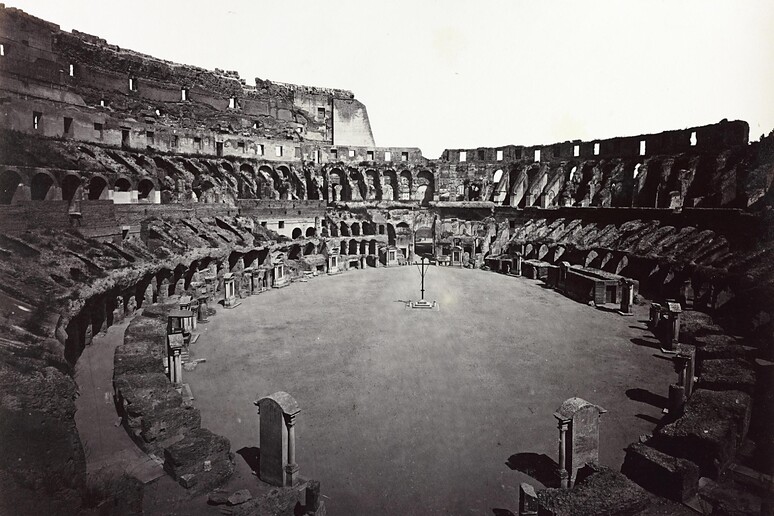The proposed restoration of the
Colosseum's killing floor has sparked a keen debate in Italy
after the culture minister suggested the storied stage for
ancient gladiatorial and animal fights could be built back into
Rome's most iconic monument.
In a tweet on Sunday, Cultural Minister Dario Francheschini
said it would "just take a little courage" to do so.
The idea to restore the stage was suggested by archeologist
Daniele Manacorda in July in the archeological journal Archeo.
In Sunday's tweet, Francheschini included a visual
comparison using a modern photo showing the exposed underground
tunnels, along with one from the mid-1800s in which the stage
was still in place over the tunnels, similar to ancient times.
Francheschini tweeted: "I really like the idea of giving the
Colosseum its arena back", along with the photos, showing the
Colosseum both before and after the excavations of the so-called
hypogeum (literally, 'under ground') area.
The 2,000-year-old symbol of Rome expanded its range of
tourist attractions when it began allowing access to the
underground pits where gladiators and beasts awaited their fate
on the ancient stage.
In a multi-million-euro project, the hypogeum underground
area was restored and opened to the public in October 2010 with
new, muted lighting effects.
Rossella Rea, superintendent of the monument formally known
as the Flavian Amphitheatre, said the hope was to have
recaptured 'some of the atmosphere' of the breathless moments
before the games commenced, when the armoured or naked fighters
and the wild animals were hauled up through 80 trap-doors.
Adding back an arena stage in the Colosseum, which attracts
five million visitors a year, would allow the cultural ministry
to sponsor and offer performances in the Colosseum, as well as
tours more suggestive of its original underground atmosphere.
Francheschini's support of the idea falls in line with other
initiatives the culture ministry has launched in recent times to
increase the number of visitors to monuments in Rome, such as
the evening multimedia light show in the Forum of Augustus that
was put in place this year to celebrate the 2000th anniversary
of the first emperor's death.
The idea of bringing back the killing floor hasn't met with
full support from experts in the field, however.
"It's a culturally weak idea, commonplace and banalizing,"
said art historian Tomaso Montanari.
"With all there is to do, with all the enormous cultural
heritage in danger, so many unknown things among our treasures,
is it right for the cultural minister to focus on the Colosseum
and its use as a performance venue?" Montanari asked.
Art historian and archeologist Salvatore Settis said Italy
is facing a "dramatic moment for cultural heritage protection"
and that the Unblock Italy law has "devastating regulations"
that make restoring the Colosseum's stage "an unreasonable
priority".
Manacorda, the archeologist who proposed the idea, said, "I
don't see any problems [in restoring the arena]. Giving the
underground back its 'undergroundness' means offering the
possibility of visiting the underground labryinth in a way that
makes sense".
Manacorda said restoring the stage would return the
Colosseum to its origins as a place for hosting public events
and shows.
Also in support of the idea is the former superintendent of
Rome's antiquities for nearly 30 years from 1976-2004, Adriano
La Regina, an archeologist and art historian.
"The Colosseum was designed to be an arena," La Regina said,
but he also cautioned that the expense to restore the arena as
well as the upkeep costs should be taken into consideration.
Construction on the iconic arena started between 70 and 72
AD under the Emperor Vespasian.
It was completed in 80 AD by his son Titus, who financed
the project from the booty his armies seized in the war against
the Jews in 66-70 AD.
Titus inaugurated it with 100 days of games including the
recreation of a sea battle between Romans and Greeks.
The father-and-son team - the so-called Flavian emperors -
built their monument to Rome's grandeur in travertine stone
before giving it the marble cladding that amazed contemporaries
- and was still its crowning glory until generations of popes
picked away at it for their own architectural testaments.
The monument is currently undergoing a 20-million-euro
clean-up and restoration sponsored by Diego Della Valle, the
billionaire owner of Italian leather goods company Tod's.
ALL RIGHTS RESERVED © Copyright ANSA











